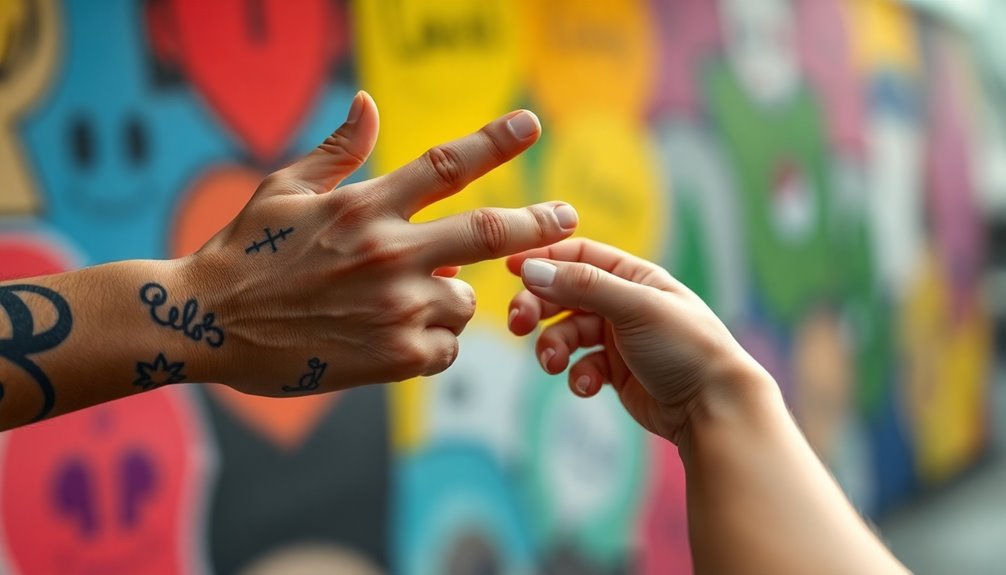Absolutely, dialogue can be rich with symbolism! When characters speak, their words often reveal deeper feelings, struggles, or ideas. For instance, repeated phrases might show their challenges or important beliefs. Sometimes, the contrast between what characters say and how they act adds even more meaning. Think of sarcasm or idioms; they can express emotions better than plain words. This clever use of dialogue helps you connect with characters and understand their journeys. It makes the story more exciting and engaging. Want to discover more fascinating ways symbolism shows up in stories? Keep exploring!
Key Takeaways
- Dialogue can symbolize larger ideas, such as freedom or struggle, reflecting characters' inner worlds and values.
- The contrast between characters' spoken words and body language enhances emotional depth and reveals true feelings.
- Repeated phrases and idioms in dialogue can create memorable motifs, symbolizing internal struggles or core themes.
- Subtext within dialogue introduces hidden meanings, enriching character interactions and reflecting deeper conflicts or emotions.
- Symbolic dialogue fosters emotional resonance, connecting readers to characters through layered interpretations of their conversations.
Defining Dialogue as Symbolism

Dialogue isn't just a tool for characters to communicate; it's a powerful form of symbolism that reveals their inner worlds. When you read a story, pay attention to what characters say. Their words can hold symbols to represent bigger ideas, like freedom or struggle. This dialogue often has layers of meaning, going beyond its literal meaning.
For instance, a character might say, "I'm fine," but their tone or body language might tell a different story. This contrast adds depth, letting you see their true feelings and motivations. Specific phrases can pop up repeatedly, symbolizing the challenges they face or the values they hold dear.
Also, think about idiomatic expressions. When characters use them, they often reflect their cultural backgrounds and beliefs. This adds richness to their conversations, giving you a peek into their lives.
In literature, dialogue can also symbolize relationships, showing power dynamics or personal growth. By understanding the symbolism in dialogue, you reveal a deeper connection to the characters and their journeys. Additionally, recognizing how characters establish healthy boundaries can further illuminate their emotional states and interpersonal dynamics.
The Role of Subtext in Dialogue

Beneath the surface of spoken words lies a rich tapestry of subtext that shapes character interactions and drives the narrative forward. When characters speak, it's not just about the words they say. The subtext—the hidden meanings and motivations—adds another layer. This makes dialogue more exciting and meaningful.
Think about how subtext can create tension. When characters express sarcasm or irony, you start to feel something deeper. You might sense unspoken feelings or hidden conflicts, which makes you want to read more. This isn't just about what's being said; it's about what's felt. You find yourself analyzing the character dynamics, which fosters a more immersive reading experience.
Notable examples, like Hemingway's "Hills Like White Elephants," show how subtext can convey profound themes without clear explanations. Instead of straightforward conversations, you discover symbolism that enriches the story.
Examples of Symbolism in Dialogue

When characters engage in conversation, their words often carry layers of meaning that go beyond the surface. You might notice that a character's choice of words can symbolize something deeper, like their internal struggles or their place in society. For example, if a character speaks in a formal tone, it might represent their status or desire for power.
Sometimes, characters repeat certain phrases or idioms in their dialogue. These repetitions can symbolize key themes, creating a memorable motif that resonates throughout the story.
Think about how different dialogue styles between characters can illustrate their unique perspectives. The contrast in their conversations might symbolize the conflicts they face, showing us the tension between them.
Also, pay attention to the subtext in their words. What they don't say often holds just as much meaning. Their true feelings or intentions might be hidden beneath the surface, allowing you, as a reader, to uncover deeper insights.
Techniques for Symbolic Dialogue

To create symbolic dialogue that resonates with readers, writers can skillfully embed metaphors and idiomatic expressions that reflect the characters' emotions and the story's themes. For example, when a character says, "It's raining cats and dogs," they might really mean they're feeling overwhelmed. This kind of symbolic dialogue brings deeper meaning to their words.
By using subtext, you can make your characters say one thing while meaning another. This adds layers to the conversation, letting readers feel the tension without spelling it out. Imagine a character saying, "I'm fine," but their tone suggests otherwise. That's powerful!
Moreover, incorporating recurring phrases can create symbols that echo throughout your story. When a character repeats a certain line, it can highlight their struggles or growth. For instance, if a character often says, "I'll find my way," it symbolizes their journey toward self-discovery.
Finally, choosing words that reflect cultural symbols can resonate with shared values. This not only enriches the dialogue but also connects readers to the characters' world.
The Impact of Symbolism on Readers

Symbolism in dialogue can profoundly shape how readers connect with a story. When writers use symbolism, it adds a magical layer to the words spoken by characters.
Just think about how Scott Fitzgerald's *Great Gatsby* uses dialogue to reveal hidden emotions.
Here's how symbolism in dialogue impacts you as a reader:
- Character Development: You can understand characters better through their symbolic words, revealing their true feelings without direct explanations.
- Deeper Meanings: You get to explore multiple layers of interpretation, making the story more engaging and thought-provoking.
- Tension Creation: When characters say one thing but mean another, it creates suspense, keeping you on the edge of your seat.
- Emotional Resonance: Symbolic dialogue helps you connect emotionally with characters, making their experiences feel real and relatable.
- Additionally, the use of symbolic dialogue can reflect emotional intelligence and maturity, as characters navigate complex emotions and relationships throughout the story.
Frequently Asked Questions
Can Words Be Considered Symbolism?
Absolutely, words can be symbols! When you hear a word, it often brings to mind ideas or feelings beyond its simple definition.
For example, the word "home" can symbolize safety, love, or comfort. Authors use words like these to create deeper meanings in their stories.
So, when you read or listen, pay attention! You might find hidden messages that make the story even more exciting and meaningful.
Enjoy uncovering these treasures!
What Is Symbolic Dialogue?
Symbolic dialogue is when characters say things that mean more than just their words. You might think it's confusing, but it's actually exciting!
By using metaphors or clever phrases, authors help you understand deeper feelings and ideas in the story. When characters talk, their words can show their emotions or struggles.
This makes the story richer and lets you connect more with the characters and their journeys. It's like a treasure hunt in words!
Can Dialogue Be a Literary Device?
Yes, dialogue can definitely be a literary device! It helps you understand characters better. Through what they say, you can feel their emotions and see their motives.
The way characters speak shows their backgrounds and relationships, too. When they use specific words or phrases, it often highlights important themes or conflicts.
What Is the Symbol Used for Dialogue?
When you think about dialogue, picture it as a bridge connecting characters to their emotions and thoughts.
It's more than just words; it's a symbol of who they are. For instance, someone using fancy words might show they're serious or from a high status, while casual speech could mean they're friendly or rebellious.
Each line creates a colorful picture, helping you understand the deeper meaning behind their conversations and the story itself.
Conclusion
In the end, dialogue can be like a treasure map, guiding readers to hidden meanings. When characters speak, their words often carry deeper messages that connect us to their feelings and experiences. Imagine a child asking, "Why is the sky blue?" That simple question can spark a big conversation about curiosity and wonder! So, remember, every chat in a story is a chance to discover something special. Let those words lead you on your own adventure!











